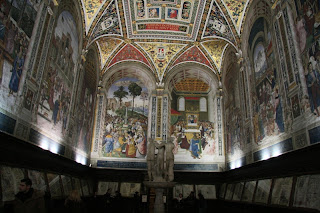
A combined ticket of 10 Euro gets you into the Opera della Metropolitana family of sites in Siena. The ticket is worth it and includes:
- Duomo (which includes the incredible Libreria Piccolomini)
- Museo dell’Opera
- Cripta (“crypt”)
- Battistero (“bapistry”)
While wandering around the Duomo, don’t miss the Piccolomini library. The library is named after the Sienese Enea Silvio Piccolomini (1405-1464) who became Pope Pius II. The frescoes here are incredible, both in composition and brilliancy of color. Another thing to pay attention to in the Duomo is the floor. The marble work and mosaics in the floor are incredible. According to the wikipedia page on the Duomo, parts of the floor are always covered (I guess to protect it) and the whole floor is uncovered only for a short period of time during the year. (On the day we visited, the parts of the floor which were covered were mostly near the crèche scene where there would be a lot of foot traffic.)
The Museo dell’Opera holds many items related to the Duomo such as original statues, the stained glassed window from the main façade, paintings, textiles, and reliquaries. No, it isn’t a museum about opera as I read in one traveler’s review on virtualtourist dot com. (Jeez) Opera is “work” as in architectural or art work. Almost everyone who visits the Museo dell’Opera heads straight for the “Facciatone” – the big façade which you can climb for a nice view of the town. The Facciatone was supposed to be the façade for a huge extension of the church which was never completed. It doesn’t get you as high as the Torre del Mangia, but it is a bit more appealing view-wise.
The Cripta is the original church (pre 1200) which the current structure was built on. It was backfilled with rubble when the current church was built. Only recently did they excavate it and open it up for viewing.
The Battistero was probably the least interesting piece (for us) but it completes the tour.
No comments:
Post a Comment
All comments are moderated. If your comment doesn't appear right away, it was likely accepted. Check back in a day if you asked a question.